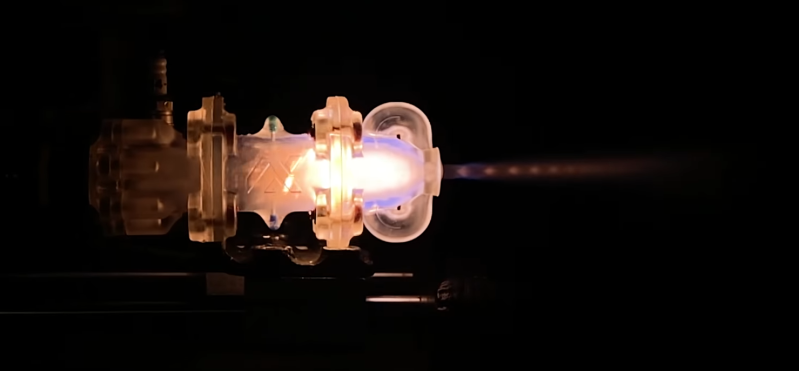3D printing is an incredible tool for prototyping and development, but the properties of the materials can be a limiting factor for functional parts. [Sam Rogers] and colleagues at [AX Technologies] have been testing and developing a small liquid-fueled rocket engine and successfully used vortex cooling to protect a resin 3D printed combustion chamber. (Video, embedded below.)
Vortex cooling works by injecting oxygen into the combustion chamber tangentially, just inside the nozzle of the engine, which creates a cooling, swirling vortex boundary layer along the chamber wall. The oxygen moves to the front end of the combustion chamber where it mixes with the fuel and ignites in the center. This does not protect the nozzle itself, which only lasts a few seconds before becoming unusable. However, thanks to the modular design of the test engine, only the small nozzle section had to be reprinted for every test. While this part could be manufactured using a metal 3D printer, the costs are still very high, especially at this experimental stage. The clear resin parts also allow the combustion observed and more accurate conclusions to be drawn from every test.
This engine intended to be used as a torch igniter for a much larger rocket engine. Fuel is injected into the front of the combustion chamber, where a spark plug is located to ignite the oxygen-fuel mixture. The flow of the oxygen and fuel is controlled by two servo-operated valves connected to a microcontroller, which is mounted with the engine on linear rails. This allows the test engine to move freely, and push against a load cell to measure thrust. The spark is created before the valves are opened to prevent a delayed ignition, which can blow up the engine, and getting the valve sequence and timing correct is critical. Many iterations and destroyed parts later, the [AX Technologies] team achieved successful ignition, with a clear supersonic Mach diamond pattern in the exhaust.
This is just one more example of 3D printing and cheap electronics allowing impressive progress on a limited budget. Another example is [Joe Barnard]’s progress in getting a model rocket to land itself with a solid fuel engine. Companies and organisations have been using 3D printed components in rocket engines for a few years now, and we’ve even seen an open source version.
















Somewhere recently I saw a video of someone making SLA-printed ceramic solid-fuel rocket engines. Their furnace they were using to cure the ceramics broke after the first attempt but it seems that it would be the right process for the parts of this engine. Though since they talk at the end about metal parts needing cooling vanes to avoid melting, perhaps it wouldn’t be enough.
I’m curious what process they’re thinking of using for “metal” parts for the finished engine. As any blacksmith will tell you, the worry with steel is not that it will melt but that it will burn – especially in an environment where you’re pumping pure oxygen around, though I guess if you get the mixture right there won’t be much left by the time the exhaust reaches the nozzle.
I think this is the video you ar talking about: https://www.youtube.com/watch?v=1p-XWqYHez4&t=91s
Youtuber that goes by integza https://www.youtube.com/watch?v=1p-XWqYHez4
Integza I believe – he does good work for someone operating in his exposed wood beam attic…
“I’m curious what process they’re thinking of using for “metal” parts for the finished engine.”
SpaceX uses DMLS, so probably that.
Yes, but which metal?
“Inconel” which is a nickel and iron alloy: https://en.wikipedia.org/wiki/Inconel
yea Inconel X-750 is the mest material for this aplication
“As any blacksmith will tell you, the worry with steel is not that it will melt but that it will burn”
A good reason to not make the parts out of steel. A nickle and iron alloy is generally what they use: https://en.wikipedia.org/wiki/Inconel
f75 cobalt chromium molybdenum
Good video. I’m not usually a fan of video format over text and photos, but this one was very informative and interesting for only ~5 min long.
Thumbs up.
Looks like recipe for an engine rich exhaust ;)
I award you 1 Internet Merit!
I enjoyed it. It really shows how much can be saved in ‘prototyping’ costs by simple iteration using 3D printing of complex parts. Imagine having to machine new parts every time something changed, or new casting molds…. Also learned a bit too. Thx for sharing.
Robert Goddard used a similar technique to cool his rocket engines but he used gasoline injected into the head end of the CC tangentially. LOx was the oxidizer and he kept his nickel engines below red heat and a Wisconsin company,Orbitec, has a patent on a LOx cooled rocket engine called LOx Vortex Cooling. And there’s an ignitor technique called resonance ignition which use no spark plug just resonance to heat any non flammable gas like nitrogen.
The Orbitec thing you mention—is that the engine for Aquarius? Wikipedia says Orbitec was going to provide an engine with a vortex-cooled combustion chamber. If so, I looked up the patent the other month, and I think I found it expired or soon to expire.
The resonance ignition thing—does that work thermoacoustically, maybe with a whistle-like thing to provide the sound? (I’ve been meaning to try yet again to learn about thermoacoustics. NightHawkInLight posted a couple of videos on it recently, but I haven’t watched them yet. And there was an introductory article in PDF form that I found a few years ago, which was written to be easy to understand without simplifying too much, but I haven’t been able to find it since.)